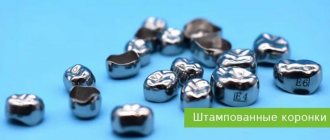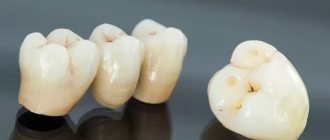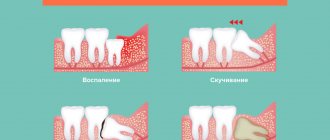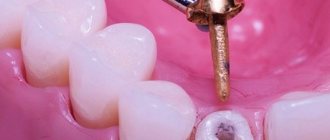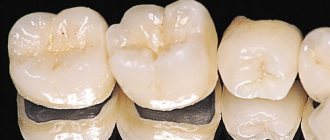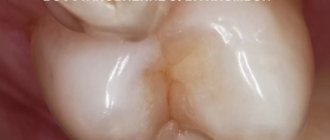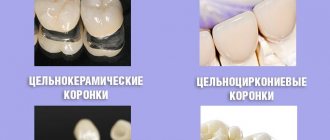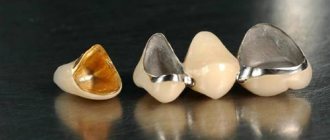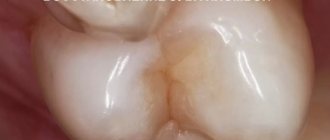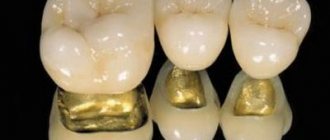A one-piece crown is a non-removable orthopedic structure, for the manufacture of which metals or their alloys are used. Previously, such prostheses were made by stamping, so they were the same. Today, they have been replaced by more advanced analogues, which differ in individual casts. They fit tightly to the neck of the tooth, which prevents the penetration of pathogenic microorganisms under them that can cause the development of caries. In addition, they will not cause irritation to surrounding tissues. Due to their strength characteristics, they are well suited for prosthetics of masticatory units. At the same time, their insufficiently presentable appearance does not make them an ideal option for incisors and canines, but their use is possible if there is a coating layer.
The CELT Dentistry Department invites you to undergo prosthetics with solid crowns in Moscow. Our orthopedists have many years of experience in practical and scientific work, which can be counted in decades. They have a powerful diagnostic and treatment base and effective new generation materials that allow them to create beautiful and functional restorations. Our dentistry cooperates with the best dental laboratories in the capital and provides treatment on the basis of an official contract with a guarantee. To find out the price of prosthetics with solid crowns, go to the “Services and prices” tab. We regularly update our price list, but we still ask you to check the numbers with our information line operators or at your doctor’s appointment.
Consultation with an orthopedic dentist—RUB 1,000.
Solid crown - RUB 5,500.
The crown is solid cast from precious stones. (special) alloy (without metal cost) - 16,500 rubles.
At CELT you can get advice from a dental specialist.
- The cost of a consultation with an orthopedic dentist is 1,000
Make an appointment
What are solid crowns, their advantages and disadvantages
A solid crown is an orthodontic structure used to replace a missing tooth. It is manufactured using the one-piece casting method. Suitable only for restoring chewing teeth; it will not look aesthetically pleasing on the front teeth. The construction is very durable and there are no cracks on it. The minimum service life is 10 years; with proper care, it can be significantly increased.
Advantages:
- affordable price;
- Full compliance with the shape of the tooth, tight fit to the gums;
- manufacturing taking into account the individual structural characteristics of patients’ teeth;
- durability;
- abrasion resistance;
- inertness towards body tissues, lack of negative impact on them;
- during installation, you can do without deep preparation, the teeth are ground down only 0.8 mm;
Flaws:
- unaesthetic appearance;
- high thermal conductivity, which is why eating hot food can cause discomfort;
- there is a possibility of allergic reactions to the components from which the crown is made.
The procedure for prosthetics with solid-cast crowns
All video presentations
The process of installing solid crowns consists of several stages:
- 1. preparation for prosthetics (sanitation of the patient’s oral cavity, treatment of pulpitis, dental caries, root canal filling);
- 2. grinding of the abutment tooth;
- 3. making impressions and transferring them to the laboratory for making a mold for casting a prosthetic structure;
- 4. crown casting;
- 5. fitting of the finished prosthetic device;
- 6. fixation of a one-piece crown in the oral cavity.
The main materials used for the manufacture of solid crowns are:
- cobalt chromium alloy;
- alloys with high titanium content;
- chromium-nickel alloy;
- noble alloys (containing precious metals).
Gold plating
In cases where the patient does not like the shiny polished surface of a metal or alloy, an additional “gold-like” layer is sprayed onto the crown. Meanwhile, some dentists note that sprayed prosthetic devices can have a negative effect on the epithelial tissues of the oral cavity.
Ceramic coating
If necessary, the patient can order the production of a one-piece prosthetic device with veneer: in this case, the front part of the crown is made of ceramic. Meanwhile, such models are significantly inferior in reliability to all-metal products.
Types of solid crowns
- Without coating - this is the most inexpensive option; it looks like a tooth made of polished metal.
- Sputtered – gold is used as the sprayed material, so the design looks more attractive in appearance. It should be taken into account that spraying can negatively affect the mucous membrane.
- With lining. A plastic or ceramic overlay is applied to the front surface, which is visible when a person smiles. During the operation of such crowns, chips of the facing material often occur.
- Combined are bridge-like prostheses made of metal and metal-ceramics. They have an attractive appearance and can be installed in the smile area and in the place of chewing teeth.
If you want to know that this is a one-piece crown, a photo of the prosthesis is given below for informational purposes.
Types of metal crowns for teeth
According to manufacturing technology, metal crowns for teeth can be stamped or solid.
Stamped
This is a budget option. To make a stamped metal crown, standard sleeves are used, which are given the required shape, resembling a case. Tooth preparation for a stamped metal crown requires the bare minimum, since it has very thin walls. Depulpation is not necessary for installation. For fixation, you need at least a third of the dental crown and a healthy root. Among the disadvantages of the design: incomplete restoration of chewing function, rapid wear, loose fit to hard tissue.
Cast
The production of a cast metal crown is made from individual impressions by casting. These are very durable structures, resistant to corrosion, they are very durable. Since solid crowns are manufactured exclusively, the risk of incomplete fit, and therefore the penetration of bacteria under the crown, is eliminated. The downside is that the preparation of teeth for a metal crown in this case requires quite significant preparation.
Types of solid metal crowns:
- simple;
- with spraying;
- with ceramic lining.
*Metal crowns on teeth with a white ceramic coating are practically indistinguishable from natural teeth, but their service life is much shorter than those made entirely of metal.
You should consult with your doctor about which metal crowns are best for a particular patient and how much it costs to install a metal crown from the selected material.
Indications and contraindications for installation
Indications:
- the crown of the “native” tooth is severely damaged;
- malocclusion;
- excessive wear of teeth;
- bruxism;
- abnormal shape, size or location of teeth.
Contraindications:
- chronic periodontitis;
- inflammatory diseases of the oral cavity;
- metal intolerance.
It is important to know. It is rational to install a one-piece crown only if the destroyed tooth tissue cannot be restored with a filling.
Crown care, oral hygiene.
Solid crowns are strong and durable, but improper care of them, as well as some bad oral habits, can significantly shorten their lifespan. First of all, it is necessary to maintain oral hygiene. In addition, you should refrain from strong mechanical impacts on the crown - for example, do not chew seeds, do not grind your teeth, and so on. For more detailed advice on oral hygiene, please contact our specialists.
Numerous surveys show that the best option is healthy teeth. Any prosthesis is only a substitute, only an analogue. But the quality and reliability of this type of prosthesis makes solid crowns a very widespread and relatively inexpensive way to regain all the delights of a healthy smile and restore lost or weakened chewing function.
Of course, only a highly qualified specialist can guarantee maximum pleasure and comfort when using a prosthesis. Our clinic provides a full range of dental prosthetic services. The full price list is available at this link.
Crown installation process
- The doctor examines the patient's oral cavity and assesses its condition. If necessary, he issues recommendations for rehabilitation.
- An imprint of the tooth and the dentition itself is taken.
- The resulting prints are sent to a dental laboratory. The patient is given temporary crowns, wearing which will help in the future to quickly adapt to permanent dentures.
- Casting the crown in the laboratory, applying the veneering material.
- When the one-piece structure is made, the doctor fixes it in the oral cavity. It is important that the end of the crown is minimally immersed in the gum and does not cause discomfort. If necessary, the prosthesis is modified.
Making crowns is a lengthy process that can take 1-2 weeks.
Stages of manufacturing solid crowns
First of all, the oral cavity is examined and the affected areas are sanitized . The first clinical stage consists of taking an impression of the dentition and the tooth itself using silicone masses. While the permanent product is being manufactured, the patient may be prescribed temporary crowns, which will not only give the smile an aesthetic appearance, but will also help speed up the process of adaptation of the gums to the dentures.
After taking the impression, a wax crown is modeled , in which the wax will subsequently be replaced with metal in a foundry laboratory, and the crown will be processed.
The second stage is to fit the product . The tooth is ground down, and the prosthesis is filled with wax and placed where it will be installed. Excess material comes out through a hole drilled in the back. The crown is removed and sent to the laboratory after smoothing out the irregularities. There it is polished and polished.
After the product is ready, it is fixed in the oral cavity so that the end of the prosthesis is submerged under the gum as little as possible . The tooth should be tightly covered; when the teeth of the antagonists are closed, there should be no unpleasant sensations. It may require some modification, but if all is well, the prosthesis is fixed with permanent rather than temporary cement. Solid crowns take a very long time to produce – the process of creating them can take several weeks.
Features of care
- Daily proper care of dentures is important: brushing teeth and interdental spaces, using rinses and dental floss.
- It is necessary to monitor the condition of your gums.
- You should visit your dentist periodically to help identify the development of gingivitis and periodontitis at an early stage. These diseases lead to crown detachment.
- If the integrity of the prosthesis is damaged, you must immediately contact the clinic for its restoration or replacement.
The one-piece construction sits tightly on the chewing element and hermetically envelops it. Therefore, the patient should not worry about the fact that pathogens or food particles can penetrate under it.
Good to know. Modern solid crowns are not afraid of solid food and are resistant to chemical and thermal irritants.
The main advantages of solid crowns
The most important advantages of solid dental crowns are:
- the highest precision of fit of the cast inner part of the crown to the tooth stump (the width of the gaps between the inner part of the prosthetic device and the surface of the tooth does not exceed several microns, and this allows you to avoid saliva, pieces of food and pathogens getting inside the crown);
- availability of spraying on the surface of the crown;
- strength and high wear resistance of the finished crown;
- availability of opportunities to recreate the natural chewing surface of the tooth;
- restoration of the chewing function of a tooth covered with a solid crown;
- availability of opportunities to recreate optimal interdental contacts;
- biological inertness, lack of toxic effects on the tissues of the human body;
- affordable prices for the production and installation of solid crowns;
- reliability (soldering is not required for the manufacture of solid-cast crowns: the prosthesis is solid and consists of one metal or alloy, which makes it more resistant to damage);
- durability of the prosthetic device (the service life of solid-cast prosthetic devices, subject to the rules of use, can exceed 10 years).
Do's and Don'ts after having a crown installed
- Water is allowed to be drunk immediately, but the patient will be able to eat food no earlier than after 2 hours.
- If prosthetics was performed on a pin, the chewing pressure on the tooth must be reduced, otherwise the pin and crown may move.
- At first, it is better to limit the consumption of drinks with coloring pigments. You should also avoid foods that are too cold or hot.
- It is recommended to cut solid food into small pieces.
- It is undesirable to eat viscous and stringy food, as it can lead to a gradual deterioration in the fixation of the prosthesis and its loss.
Cost of installing solid crowns
The cost depends on the design features of the prosthesis and the materials that will be used in its manufacture. The cost of the service may also include the cost of obtaining an x-ray and installing a temporary prosthesis.
Specialists at the Saint-Dent Clinic dental clinic in Moscow offer clients high-quality dental prosthetics with solid crowns with a guarantee of long-term use. The clinic's doctors have many years of experience and regularly take specialized courses in the best dental centers in Europe, America and Asia. To provide medical services, the latest equipment and modern certified materials are used. Contacts of the clinic are located here CONTACTS. You can find out the cost of services in this PRICES section.
How are solid crowns made?
The production and installation of a one-piece prosthesis takes place in several stages.
Like any other dental procedure, prosthetics begins with an examination. The dentist makes an impression of the supporting tooth and the entire dentition - this will be needed to create a temporary prosthesis and cast the crown.
Preparation is carried out - preparing the abutment tooth for the prosthesis, cutting and grinding the hard tissues of the tooth. There are different types of odontopreparation - ultrasound, laser, tunnel. The differences lie only in the method of removing hard tooth tissue.
An impression is again made of a number of teeth, and temporary dentures can also be installed - this will speed up the adaptation. Next comes modeling of the wax crown. After this, a prosthesis is cast in a special laboratory based on a wax model.
After all the necessary measurements, the dimensions of the prosthesis and the tightness of the fit are checked. A well-fitted crown does not cause pain, does not change the bite, does not destroy or deform the surrounding teeth. Therefore, high-quality prosthetics requires ideal precision and a high level of specialist training - there should not be the slightest gap. If a discrepancy in size is detected, the prosthesis is sent for revision.
The final stage of prosthetics is the actual installation of the prosthesis. After all adjustments and adjustments, the prosthesis is disinfected, degreased and dried. The patient's teeth are isolated from saliva and degreased. The cement-filled crown is carefully placed on the supporting tooth, and excess fixing material is removed. After the cement has hardened, the prosthesis is ready.
